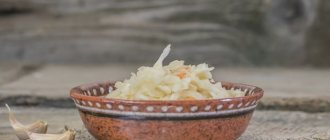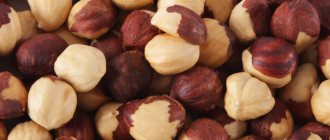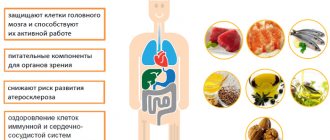Cauliflower (Brassica oleracea), commonly known as “curly cabbage,” is a vegetable crop from the cultivar group of Cabbage, subspecies botrytis. The closest relative and genetic ancestor is broccoli: it is not the leaves that are edible, but the immature inflorescences. Cauliflower looks like an uneven, sometimes interrupted head of cabbage, framed by foliage. The place of origin is considered to be the Mediterranean, but for a long time it was grown in Syria and other eastern countries, where it received the name “Syrian cabbage”. The name “colored”, as we know it, stuck because of its voluminous and strong inflorescences. Currently, the vegetable is actively grown in Europe, America, China and Japan. Germany is the record holder among all countries for its cultivation. In the CIS countries, cauliflower makes up only 1% of all cabbage crops, so most often you will find a foreign product in stores.
Composition and calorie content of cauliflower
Cauliflower contains more than 10 vitamins and 15 amino acids, as well as useful micro- and macroelements necessary for the normal functioning of the body.
Calorie content of cauliflower is 30 kcal per 100 grams of product, of which:
- Proteins - 2.5 g;
- Fats - 0.3 g;
- Carbohydrates - 4.2 g;
- Organic acids - 0.1 g;
- Dietary fiber - 2.1 g;
- Water - 90 g;
- Ash - 0.8 g.
Vitamins per 100 g:
- Vitamin A, RE - 3 mcg;
- Beta Carotene - 0.02 mg;
- Vitamin B1, thiamine - 0.1 mg;
- Vitamin B2, riboflavin - 0.1 mg;
- Vitamin B4, choline - 45.2 mg;
- Vitamin B5, pantothenic acid - 0.9 mg;
- Vitamin B6, pyridoxine - 0.16 mg;
- Vitamin B9, folate - 23 mcg;
- Vitamin C, ascorbic acid - 70 mg;
- Vitamin E, alpha tocopherol, TE - 0.2 mg;
- Vitamin H, biotin - 1.5 mcg;
- Vitamin K, phylloquinone - 16 mcg;
- Vitamin RR, NE - 1 mg;
- Niacin - 0.6 mg.
Macroelements per 100 g:
- Potassium, K - 210 mg;
- Calcium, Ca - 26 mg;
- Magnesium, Mg - 17 mg;
- Sodium, Na - 10 mg;
- Phosphorus, Ph - 51 mg.
Microelements per 100 g:
- Iron, Fe - 1.4 mg;
- Manganese, Mn - 0.156 mg;
- Copper, Cu - 42 μg;
- Selenium, Se - 0.6 μg;
- Fluorine, F - 1 µg;
- Zinc, Zn - 0.28 mg.
Digestible carbohydrates per 100 g:
- Starch and dextrins - 0.4 g;
- Mono- and disaccharides (sugars) - 3.8 g.
Essential amino acids per 100 g:
- Valine - 0.140 g;
- Histidine - 0.042 g;
- Isoleucine - 0.084 g;
- Leucine - 0.130 g;
- Lysine - 0.110 g;
- Methionine - 0.029 g;
- Threonine - 0.080 g;
- Tryptophan - 0.027 g;
- Phenylalanine - 0.080 g.
Essential amino acids per 100 g:
- Alanine - 0.180 g;
- Arginine - 0.091 g;
- Glycine - 0.084 g;
- Proline - 0.100 g;
- Serine - 0.120 g;
- Tyrosine - 0.049 g;
- Cystine - 0.014 g;
- Aspartic acid - 0.190 g;
- Glutamic acid - 0.260 g.
Fatty, saturated fatty, monounsaturated and polyunsaturated acids per 100 g:
- Oleic (omega-9) - 0.026 g;
- Linoleic (omega-6) - 0.030 g;
- Linolenic (omega-3) - 0.187 g;
- Palmitic – 0.069 g;
- Stearic – 0.007 g.
100 grams of cauliflower contains 70% of the daily dose of ascorbic acid.
A share of 18% comes from pantothenic acid, which increases the absorption of other vitamins, but almost half of this substance is lost during heat treatment. Vitamin K contained in cauliflower helps with hemocoagulation, increasing blood clotting. In terms of the amount of high-quality proteins, “kale” surpasses all other vegetables of this type. Consumption of cauliflower is recommended for type 2 diabetes due to its low sucrose content.
This type of cabbage is recommended for dieting: its calorie content varies slightly depending on the method of preparation, and the content of tartronic acid prevents the accumulation of fatty deposits and breaks down existing ones.
Useful properties of cauliflower
The beneficial properties of this product are undeniable: many studies have been conducted both in Europe and in Russia, which reveal not only the general effect on the body, but also individual diseases.
The benefits of cauliflower and dishes containing it:
- Strengthens the immune system
. Cauliflower protects the body from infectious diseases thanks to vitamins A and C. - Improves vision
. Eating this vegetable promotes the proper functioning of the visual organs. - Strengthens bones
. Microelements in cauliflower improve the condition of hair, nails and bones, strengthening them and reducing fragility. - Increases metabolism
. It helps with both diet and the normal function of cell division and red blood cell production. - Baldness
. Cauliflower accelerates hair growth and epidermal regeneration. Men are recommended to use it for early baldness and the formation of bald spots. - Cell regeneration
. This process rejuvenates the skin and the entire body as a whole. - Prevention of oncology
. Indole-3-carbinol provides prevention of many cancers, including the uterus, ovaries and prostate. - Improved digestion
. Glucafarin reduces the risk of gastritis and gastric ulcers. - Healing
. Cauliflower has anti-inflammatory properties that promote wound healing within the body. - Improves heart function
. Potassium in cauliflower helps not only to prevent cardiovascular diseases, but, when combined with sodium, improves short-term memory and the nervous system.
It is worth mentioning separately about the use of cabbage during pregnancy and lactation:
- Formation of the fetus
. Folic acid ensures a high-quality pregnancy during all semesters, and also reduces the risk of birth defects in the child. - Natural laxative
. Cauliflower relieves the expectant mother of problems with constipation and difficulty digesting food. - Reduces stretch marks
. Natural collagen reduces the risk of stretch marks during childbirth.
Note! Cauliflower can be consumed during lactation. You can also give boiled cauliflower puree as the first food for your baby.
During pregnancy
Regular moderate consumption of inflorescences will support the functioning of the entire body of the expectant mother, the health of her skin and bones, and will help the fetus to form correctly. The product will help you avoid gaining excess weight and remove swelling of your limbs and face.
Cabbage also has other beneficial properties:
- removal of toxins from the intestines, normalization of stool;
- formation of the brain and spinal cord, heart muscles of the child in the womb (thanks to folic acid);
- maintaining and strengthening immunity;
- giving the skin elasticity (helps avoid the appearance of stretch marks on the stomach);
- decreased appetite.
Harm of cauliflower and contraindications for consumption
Despite all the beneficial properties, cauliflower has some precautions and contraindications for consumption that must be observed.
We use cauliflower with caution in the following cases:
- Increased acidity
. With such a symptom of stomach dysfunction, this type of cabbage can cause heartburn. - Intestinal spasms
. Cauliflower can increase the occurrence of these unpleasant symptoms. - Peptic ulcer disease is in remission
. You should stop eating cabbage if irritation or pain occurs. - Kidney disease or gout
. The purines in this vegetable can increase the concentration of uric acid, which can worsen the condition. - Thyroid diseases
. All cruciferous vegetables impair hormone production and can lead to goiter.
Absolute contraindications to eating cauliflower:
- Exacerbation of diseases of the gastrointestinal tract
. Cauliflower is contraindicated by doctors for this diagnosis. - Allergic reactions or fever
. This vegetable improves metabolism, which allows harmful substances to penetrate into all parts of the body during such diseases. - Postoperative period
. It is not recommended to consume this cabbage after surgery on the chest or abdominal cavity.
Note! Cauliflower cannot be cooked in aluminum cookware: the metal oxidizes and its compounds are released into the product.
Cooking roasted cauliflower
Fried cauliflower is used in various dishes, providing them with wonderful taste and satiety.
Frying allows you to completely neutralize cauliflower from possible sources of infection and helminths. In order not to get a lot of harm from using fat, you can fry on a grill (calorizator). Frying forms a crust on the surface of the cabbage, protecting it from losing a large number of beneficial properties.
We invite you to familiarize yourself, please tell me is it possible to cook pilaf from round rice? thanks in advance!
Recipes with cauliflower
There are many ways to cook cauliflower, but when choosing this vegetable you need to pay attention to several signs that will help determine the quality of the product:
- Weight
. The head of cauliflower must be strong and heavy, otherwise, due to the loose structure of the inflorescences, they will fall apart during cooking. It is also worth paying attention to the absence of soft areas: they will deteriorate first. - Foliage
. A head of cabbage surrounded by leaves is the main indicator of freshness. - Color
. The inflorescences can be white to cream in color with a purple tint, but without dark spots that indicate spoilage of the product. - Temperature
. You should not buy cauliflower lying on a regular counter: it can be stored for 7 to 10 days at a temperature of 0°C
Recipes with cauliflower:
- Cauliflower baked with pork
. Divide a medium head of cauliflower into small florets and boil in boiling salted water for 7-8 minutes. Cut 500 grams of pork into medium pieces, fry in a dry frying pan until golden brown, place in a baking dish greased with butter, cover with foil, making small holes, bake at 200 degrees for 15 minutes. At this time, mix cabbage, 2 cloves of crushed garlic, salt, pepper and 150 grams of sour cream. Place the resulting mixture into the pan over the pork, sprinkle with grated cheese. Bake until golden brown without foil. - Cabbage with sauce
. Wash a large head of cauliflower, separate the inflorescences, add cold water, bring to a boil, add salt and cook for 10-15 minutes, drain in a colander. Finely chop onions (100 grams) and 2 cloves of garlic, fry in a frying pan until golden brown. Cut 150 grams of ham into small cubes, add to the onion and garlic. Peel tomatoes (350 grams), chop, add to the resulting mixture in the frying pan. Put 1 tablespoon of olive oil and parsley there, season with salt and pepper, cook until slightly thick, remove from heat. Fry the cabbage in breading, pour over the sauce, and serve hot. - "Curly mushrooms"
. Divide the head of cauliflower into inflorescences, rinse in warm water and simmer for 15 minutes with half a glass of milk. In a separate frying pan, simmer 500 grams of diced champignons. Add another half glass of milk to the cabbage, almost ready mushrooms, salt and add allspice to taste. Simmer until the mushrooms and cabbage are soft. Before serving, sprinkle with grated cheese and herbs.
If you do not have time to prepare complex dishes, then cauliflower can be boiled in salted water and fried in batter or breading until golden brown in vegetable oil. This dish can be served with herbs and your favorite sauce. Cauliflower can also be eaten raw, but this way it poorly reveals its flavor properties, so many chefs prefer to heat treat this vegetable.
How to use inflorescences for weight loss
There are diets that consist of eating boiled inflorescences 3-5 times a day and drinking cabbage juice. Such programs are complex and suitable only for a healthy body; their maximum duration is 5-8 days.
It is more useful to create a healthy diet with a reduction in the consumption of sugars, flour, fatty and fried foods, based on preparing dishes from this vegetable (without salt and seasonings).
The salad or soup weight loss method is considered effective:
- Inflorescences (800-900 g) are mixed with tomato, Iceberg lettuce and herbs, seasoned with olive oil. The entire volume is divided into 5 meals. The duration of the diet is 3-5 days. You can lose about 5-7 kg per course.
- The puree soup is prepared from boiled cabbage, chicken breast, carrots and onions. Boiled products are crushed in a blender to a mushy state. The course duration is 3 days, the effect is up to 5 kg of weight loss.
Interesting facts about cauliflower
People often call this vegetable “curd cabbage” because of its external resemblance to grain curd.
It can also be noted that the cauliflower inflorescence vaguely resembles a lush tree, which can attract the attention of a child when trying to feed him this unfamiliar, but extremely useful vegetable. When it was grown in Syria, cauliflower was not as early and had a bitter taste. The eastern scientist Avicenna more than a thousand years ago recommended eating Syrian cabbage in winter to replenish vitamins. It was first described in Arab countries.
In the 12th century, this type of cabbage was brought to Spain and Cyprus, and for many centuries it was the source of seeds for European countries. In the 14th century, some varieties began to be actively grown in England and southern European countries.
Cauliflower appeared in Russia during the reign of Catherine II, but was grown only by the upper classes, who bought seeds on the island of Malta for huge sums. Since this variety is very demanding on the climate, it did not become widespread until A. Bolotov developed a frost-resistant variety.
How to cook cauliflower - watch the video:
This “curly” vegetable ranks high among all the others in terms of useful elements and vitamins. Thus, a high-quality product is quite often found on the shelves, so it is worth including it into your diet at least as an experiment. Once you are convinced of the benefits of cauliflower, you will want to cook it again.











